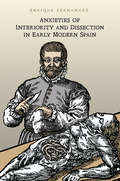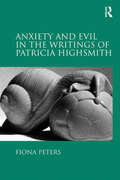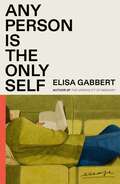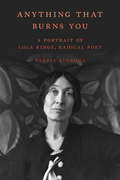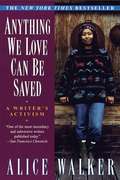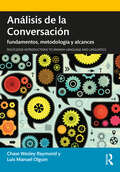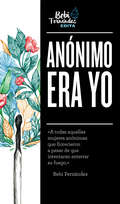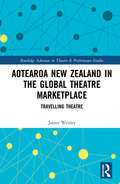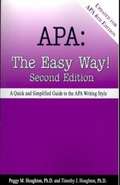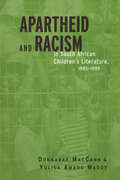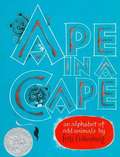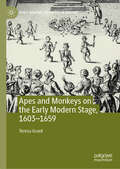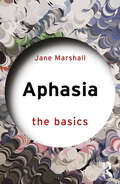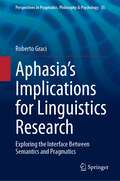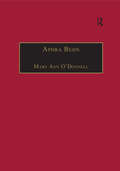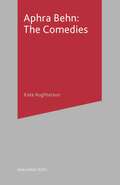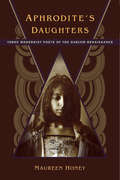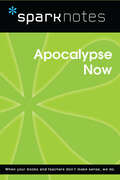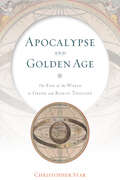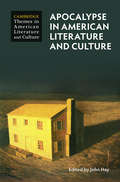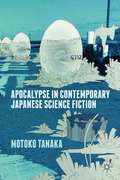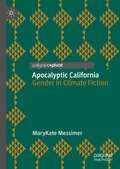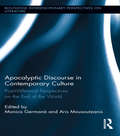- Table View
- List View
Anxieties of Interiority and Dissection in Early Modern Spain
by Enrique FernandezAnxieties of Interiority and Dissection in Early Modern Spain brings the study of Europe's "culture of dissection" to the Iberian peninsula, presenting a neglected episode in the development of the modern concept of the self. Enrique Fernandez explores the ways in which sixteenth and seventeenth-century anatomical research stimulated both a sense of interiority and a fear of that interior's exposure and punishment by the early modern state.Examining works by Miguel de Cervantes, María de Zayas, Fray Luis de Granada, and Francisco de Quevedo, Fernandez highlights the existence of narratives in which the author creates a surrogate self on paper, then "dissects" it. He argues that these texts share a fearful awareness of having a complex inner self in a country where one's interiority was under permanent threat of punitive exposure by the Inquisition or the state. A sophisticated analysis of literary, religious, and medical practice in early modern Spain, Fernandez's work will interest scholars working on questions of early modern science, medicine, and body politics.
Anxiety and Evil in the Writings of Patricia Highsmith: Writing Aristocratic Identity In Late Medieval French And English Literatures
by Fiona PetersDrawing on an impressive range of secondary material, including many elusive reviews, interviews and articles from the under-explored Highsmith Archive, Fiona Peters suggests that the usual generic distinctions -crime fiction, mystery, suspense - have been largely unhelpful in elucidating Patricia Highsmith's novels. Peters analyzes a significant selection of Highsmith's works, chosen with a view towards demonstrating the range of her oeuvre while also identifying the main themes and preoccupations running throughout her career. Adopting a psychoanalytic approach, Peters proposes a reading of Highsmith that subordinates murder as the primary focus of the novels in favor of the gaps between periods of activity represented through anxiety, waiting, lack of desire and evil. Her close readings of the Ripley series, This Sweet Sickness, Deep Water, The Tremor of Forgery, and The Cry of the Owl, among others, reveal and illuminate Highsmith's concern with minutiae and the particular. Peters makes a strong case that the specific disturbances within her texts have resulted in Highsmith's writing remaining resistant to explication and to the more sophisticated interpretative strategies that would seek to position her within a specific genre.
Any Person Is the Only Self: Essays
by Elisa GabbertContagiously curious essays on reading, art, and the life of the mind, from the acclaimed author of The Unreality of Memory. Who are we when we read? When we journal? Are we more ourselves alone or with friends? Right now or in memory? How does time transform us and the art we love? In sixteen dazzling, expansive essays, the acclaimed essayist and poet Elisa Gabbert explores a life lived alongside books of all kinds: dog-eared and destroyed, cherished and discarded, classic and clichėd, familiar and profoundly new. She turns her witty, searching mind to the writers she admires, from Plath to Proust, and the themes that bind them—chance, freedom, envy, ambition, nostalgia, and happiness. She takes us to the strange edges of art and culture, from hair metal to surf movies to party fiction. Any Person Is the Only Self is a love letter to literature and to life, inviting us to think alongside one of our most thrilling and versatile critics.
Anybody Can Do Anything
by Betty Macdonald"THE BEST THING about the depression was the way it reunited our family and gave my sister Mary a real opportunity to prove that anybody can do anything, especially Betty." After divorcing her first husband, Betty returns home with her two children. With humor, she tells of her many jobs, including the one where she picked up TB from a boss. (See "The Plague and I," also available from Bookshare.) She relates her daughter's escopades as they grow into teenagers, paints a picture of what it was like for some families to live through the depression.
Anything That Burns You
by Tereese SvobodaThis is the first full-length biography of this fascinating woman of arts and letters who was a major force both within the literary salons of New York City in the early 20th Century, but also on the streets as a protester of inequality and injustice which was rampant at the time. Author Terese Svoboda, award-winning poet, non-fiction writer, novelist, and videographer, provides a rich and detailed account of the life and world of Lola Ridge, poet, artist, editor, and activist for the cause of women’s rights, workers rights, racial equality and social reform. From her childhood as a newly arrived Irish immigrant in the grim mining towns of New Zealand with her mother who had fled with her infant daughter to Down Under in order to escape one bad marriage only to find herself in another; to her years as a budding poet and artist in Sydney, Australia, which, even in its early days was a socially progressive and influential artistic hub; to her migration to America and the cities of San Francisco, Chicago, and New York, where she joined forces with the literary and artistic world in the years leading up to WWI, and helped start and edit two major journals of the time, Others and Broom, as well as go on to publish several books of poetry. At one time considered one of the most popular poets of her day (in an era when poetry was a top-selling genre and even available for sale at newsstands), she later fell out of critical favor due to her realistic and impassioned verse that looked head on at the major social woes of society--poverty, racism, labor inequality, unequal wealth distribution, and the appalling conditions in which the immigrant population was forced to live in the tenements of New York and elsewhere--subjects deemed ill-suited for a femaie poet. Moreover,her work and appearances alongside the likes of Margaret Sanger, Emma Goldman, Will Durant and other socialists and radicals, and her public outcry in the wake of the Triangle Shirt Waist Factory Fire and the executions of Sacco & Vanzetti put her in the line of fire not only of the police and government, but also the literary pundits who criticized her activism as being excessive and melodramatic. With this lively portrait of the artistic and socially active world (100 years before “occupy Wall Street) Svoboda gives us a veritable who’s who of all the key players in the arts, literature and radical politics of the time, in which Lola Ridge stood front and center, a traialblazer for women, poetry and human rights far ahead of her time. But as Svoboda argues, she was sadly marginalized in later years along with many pioneering and primarily female poets of her day such as Marianne Moore, H.D., and Amy Lowell, who have only recently been recognized for their major contribution to our literature. With spirited prose, impeccable research, insight and wit, Svoboda has restored this vastly undervalued and overlooked author to her rightful place in this country’s literary and social history.
Anything We Love Can Be Saved: A Writer's Activism
by Alice WalkerIn Anything We Love Can Be Saved, Alice Walker writes about her life as an activist, in a book rich in the belief that the world is saveable, if only we will act. Speaking from her heart on a wide range of topics--religion and the spirit, feminism and race, families and identity, politics and social change--Walker begins with a moving autobiographical essay in which she describes her own spiritual growth and roots in activism. She goes on to explore many important private and public issues: being a daughter and raising one, dreadlocks, banned books, civil rights, and gender communication. She writes about Zora Neale Hurston and Salman Rushdie and offers advice to Bill Clinton. Here is a wise woman's thoughts as she interacts with the world today, and an important portrait of an activist writer's life.
Anything You Can Do: A Grammar Tales Book to Support Grammar and Language Development in Children (Grammar Tales)
by Jessica HabibBelle loves to try and get involved with all of the things that her big bother, Pete, can do, but she’s not quite big enough to sprint or swim or read. They discover things that they can both do. Targeting Subject-Verb sentences, pronouns and the auxiliaries ‘can’ and ‘do’, this book provides repeated examples of early developing syntax and morphology which will engage and excite the reader while building pre-literacy skills and make learning fun, as well as exposing children to multiple models of the target grammar form. Perfect for a speech and language therapy session, this book is an ideal starting point for targeting client goals and can also be enjoyed at school or home to reinforce what has been taught in the therapy session.
Análisis de la Conversación: fundamentos, metodología y alcances
by Chase Wesley Raymond Luis Manuel OlguínAnálisis de la Conversación: fundamentos, metodología y alcances ofrece la primera introducción comprehensiva al Análisis de la Conversación (AC) en español y con datos conversacionales disponibles en línea. El libro está organizado en nueve capítulos. En los capítulos iniciales, se presenta el AC como una disciplina y método analítico para el estudio del habla y otras formas de conducta humana en la interacción social, se hace un breve recuento histórico del desarrollo de la perspectiva analítico-conversacional y se introduce a los lectores al sistema de transcripción usado en el AC. Los capítulos siguientes están dedicados a explorar cuatro dominios claves en la organización de la conversación espontánea: la toma de turnos, las secuencias de acciones, la preferencia y la enmienda, destacando la importancia de prácticas del diseño de turno en cada dominio. Seguidamente, se discute la conexión entre organizaciones y prácticas del habla en interacción y contextos sociales e identidades de los participantes en conversación. El libro concluye ofreciendo una serie de sugerencias para la investigación analítico-conversacional en español y señalando su relevancia para la indagación de la interacción en contextos legales, políticos, médicos, tecnológicos, entre otros. Cada capítulo incluye ejemplos tomados de conversaciones auténticas en distintas variedades de español, cuyos audios pueden ser consultados directamente en línea. Con el fin de revisar y profundizar lo aprendido, cada capítulo ofrece un apartado final con preguntas, actividades y lecturas adicionales. Como apéndices al libro, se ofrecen, además, un glosario de términos bidireccional español–inglés y un sumario con las convenciones de transcripción más usadas. Escrito enteramente en español, el libro ofrece una introducción actual, comprehensiva y amigable al AC y sus aplicaciones por lo que constituye una fuente de referencia ideal para estudiantes, instructores e investigadores en lingüística (hispánica), sociología y comunicaciones. Análisis de la Conversación provides the first comprehensive, Spanish-language introduction to the field of Conversation Analysis (CA), utilizing conversational data that is publicly available online. The book is organized in nine chapters. The opening chapters introduce Conversation Analysis as a unique theory and method to study language and other forms of conduct in social interaction. Readers are presented with a history of the development of this framework for analyzing interaction and introduced to the transcription system used in CA. The following chapters explore four key domains of organization within spontaneous conversation—turn-taking, preference, sequence, and repair—highlighting the importance of turn design practices in each. The authors then review the connection of these organizations and practices to social contexts and participant identities, and they conclude by suggesting a range of avenues for future research on Spanish conversation, including its relevance in specific legal, political, medical, and technological settings. Each chapter includes a variety of examples from authentic Spanish conversation, which readers can consult directly online. Each chapter is additionally accompanied by a set of questions and activities that allow readers to check and reinforce their understanding, as well as lists of additional readings for readers interested in more specific topics. Glossaries of technical vocabulary—both Spanish-English and English-Spanish—are included as appendices, along with a summary of transcription system notation. Written entirely in Spanish, this book presents a thorough and engaging introduction to Conversation Analysis and its applications. It is ideal for students, instructors, and researchers in Hispanic Studies, (Spanish) Linguistics, Sociology, and Communication Studies.
Anónimo era yo
by Varias autorasAhora las voces de Margarita Hickey, Juana Inés de la Cruz, Emilia Pardo Bazán, Rosalía de Castro y Alfonsina Storni suenan más alto que nunca bajo el lápiz inflamable de Bebi. Un libro de la colección «Bebi Edita». Ellas, que escribían escondiendo sus nombres; ellas, que vivían callando; ellas, todas ellas, que fueron sin poder ser y que, aun así, gritaron al mundo su poesía. En las voces de varias poetas encontramos una y otra vez, como una canción demasiado conocida, el miedo, la culpa, la represión. Con su mirada explosiva, Bebi inflama todas las palabras que subyacen en los textos de estas mujeres que se vieron obligadas a vivir a media voz. Bebi empezó incendiando las redes con miles de seguidores. Poco después inflamó libros; Indomable es un éxito de ventas. Ahora llega para editar su propia colección y seguir quemando.
Aotearoa New Zealand in the Global Theatre Marketplace: Travelling Theatre (Routledge Advances in Theatre & Performance Studies)
by James WenleyAotearoa New Zealand in the Global Theatre Marketplace offers a case study of how the theatre of Aotearoa has toured, represented and marketed itself on the global stage. How has New Zealand work attempted to stand out, differentiate itself, and get seen by audiences internationally? This book examines the journeys of a dynamic range of culturally and theatrically innovative works created by Aotearoa New Zealand theatre makers that have toured and been performed across time, place and theatrical space: from Moana Oceania to the Edinburgh Festival Fringe, from a Māori Shakespeare adaptation to an immersive zombie theatre experience. Drawing on postcolonialism, transnationalism, cosmopolitanism and globality to understand how Aotearoa New Zealand has imagined and conceived of itself through drama, the author investigates how these representations might be read and received by audiences around the world, variously reinforcing and complicating conceptions of New Zealand national identity. Developing concepts of theatrical mobility, portability and the market, this study engages with the whole theatrical enterprise as a play travels from concept and scripting through to funding, marketing, performance and the critical response by reviewers and commentators. This book will be of global interest to academics, producers and theatre artists as a significant resource for the theory and practice of theatre touring and cross-cultural performance and reception.
Apa: The Easy Way! (2nd Edition)
by Peggy M. Houghton Timothy J. Houghton Michele M. PrattAmerican Psychological Association (APA) guideline handbook
Apartheid and Racism in South African Children's Literature 1985-1995: Apartheid And Racism In South African Children's Literature 1985-1995 (Children's Literature and Culture #15)
by Donnarae MacCann Yulisa Amadu MaddyFirst Published in 2002. Routledge is an imprint of Taylor & Francis, an informa company.
Apes and Monkeys on the Early Modern Stage, 1603–1659 (Early Modern Literature in History)
by Teresa GrantThis book is the first full-length study of apes and monkeys on the early modern stage. It broadens the scope of existing scholarship by situating the apes glimpsed in Shakespeare’s plays in the wider context of the many uncelebrated uses by other playwrights, c. 1603-1659. The book investigates the theatrical appearances of real monkeys, actors dressed up as apes, and characters mistaken for them, arguing that the ape trope is so insistent in early modern drama that it becomes a structural metaphor. It addresses both plays and masques across the period, arguing that the ways of seeing in these different kinds of theatre make apes mean differently in their generic contexts. Grounded in historicist readings, this book also draws significantly on the field of ritual studies and the new intersectional discipline of animal performance studies.
Aphasia: The Basics (The Basics)
by Jane MarshallThis book provides a comprehensive yet accessible introduction to aphasia, or loss of language, a complex condition that affects approximately a third of stroke survivors.It describes the varied manifestations of aphasia on speech, comprehension, reading and writing. Chapters explore how aphasia presents across different languages and in bilingualism, as well as the impacts of aphasia on a person’s life and the effects for family members. The text also considers recovery in aphasia and how that recovery can be enhanced by a range of interventions. All topics are informed by extensive research and personal accounts of individuals living with aphasia.Anyone interested in language needs to know about aphasia and will find here the perfect beginner’s guide. The book provides an invaluable introduction to aphasia for students of speech and language therapy, health professionals and others with an interest in stroke care. It also offers easy-to-read answers to many of the questions posed by family members of stroke survivors.
Aphasia’s Implications for Linguistics Research: Exploring the Interface Between Semantics and Pragmatics (Perspectives in Pragmatics, Philosophy & Psychology #35)
by Roberto GraciThis volume stresses the importance of a multidisciplinary perspective in deepening knowledge of the interface between semantics and pragmatics. It thoroughly investigates concepts belonging to Neo-Gricean and post-Gricean theories. Theoretical research in pragmatics has challenged the idea of a close relation between literal meaning and the explicitly conveyed proposition, claiming that situational context is responsible for an ongoing process of adjusting and revising what a speaker says. Similarly, recent discoveries from the clinical side have highlighted the importance of extra-linguistic sources and the cognitive context in the syntactic and semantic competence of people with language disorders. The productive comparison between reflections from theoretical pragmatics and the most recent developments in cognitive sciences provides an authentic way of addressing traditional philosophical issues, moving them to a new fertile ground. The research herein is gathered across disciplines to provide theoretical and clinical contributions and collaborations, making this book broadly appropriate to students, researchers and professionals in the fields.
Aphra Behn: An Annotated Bibliography of Primary and Secondary Sources (Approaches To Teaching World Literature Ser. #127)
by Mary Ann O'DonnellThis annotated bibliography constitutes a thoroughly revised and more easily readable study of Behn's publications, of those edited or translated by her, of publications that included her works, and of writings ascribed to her, along with an annotated bibliography of over 1600 works about her from 1671 to 2001, with an unannotated update covering 2002. The augmented primary bibliography describes all known editions and issues of her works to 1702, and adds a catalogue of editions to 2002, including on-line sources. The secondary bibliography adds close to 1000 items published since 1984 to the original 600 of the first edition along with about 175 more from 1671 to 1984, with attention to materials not in English. New appendices include a list of dedicatees, actors, recent productions (with reviews), and provenances. This volume will be invaluable for book dealers, collectors and librarians, as well as students and scholars of Aphra Behn and of Restoration literature.
Aphra Behn: The Comedies
by Kate AughtersonKate Aughterson provides readers with an approachable and fascinating critical guide to the dramatic works of an important seventeenth-century woman writer. Aughterson analyses Aphra Behn's abilities as a playwright, showing particularly how she skillfully employs comic and dramatic conventions to radical ends, and how she forces her audience to engage with issues about gender and sexuality whilst retaining her witty and accessible style. Chapters in the first part of the book provide close readings of the comedies, addressing such topics as openings, endings, character types, staging, and politics and society. In the second part, Aughterson not only examines Behn's literary career and the Restoration contexts of her plays, but also looks at some sample criticism and explores Behn's drama as performance.
Aphrodite's Daughters: Three Modernist Poets of the Harlem Renaissance
by Maureen HoneyThe Harlem Renaissance was a watershed moment for racial uplift, poetic innovation, sexual liberation, and female empowerment. Aphrodite's Daughters introduces us to three amazing women who were at the forefront of all these developments, poetic iconoclasts who pioneered new and candidly erotic forms of female self-expression. Maureen Honey paints a vivid portrait of three African American women--Angelina Weld Grimké, Gwendolyn B. Bennett, and Mae V. Cowdery--who came from very different backgrounds but converged in late 1920s Harlem to leave a major mark on the literary landscape. She examines the varied ways these poets articulated female sexual desire, ranging from Grimké's invocation of a Sapphic goddess figure to Cowdery's frank depiction of bisexual erotics to Bennett's risky exploration of the borders between sexual pleasure and pain. Yet Honey also considers how they were united in their commitment to the female body as a primary source of meaning, strength, and transcendence. The product of extensive archival research, Aphrodite's Daughters draws from Grimké, Bennett, and Cowdery's published and unpublished poetry, along with rare periodicals and biographical materials, to immerse us in the lives of these remarkable women and the world in which they lived. It thus not only shows us how their artistic contributions and cultural interventions were vital to their own era, but also demonstrates how the poetic heart of their work keeps on beating.
Apocalypse Now (SparkNotes Film Guide)
by SparkNotesApocalypse Now (SparkNotes Film Guide) Making the reading experience fun! SparkNotes Film Guides are one-stop guides to great works of film–masterpieces that are the foundations of filmmaking and film studies. Inside each guide you&’ll find thorough, insightful overviews of films from a variety of genres, styles, and time periods. Each film guide contains: Information about the director and the context in which the film was made Thoughtful analysis of major characters Details about themes, motifs, and symbols Explanations of the most important lines of dialogue In-depth discussions about what makes a film so remarkable SparkNotes Film Guides are an invaluable resource for students or anyone who wants to gain a deeper understanding of the great films they know and love.
Apocalypse and Golden Age: The End of the World in Greek and Roman Thought
by Christopher StarHow did the ancient Greeks and Romans envision the end of the world?What is the long-term future of the human race? Will the world always remain as it is or will it undergo a catastrophic change? What role do the gods, human morality, and the forces of nature play in bringing about the end of the world? In Apocalypse and Golden Age, Christopher Star reveals the answers that Greek and Roman authors gave to these questions. The first large-scale investigation of the various scenarios for the end of the world in classical texts, this book demonstrates that key thinkers often viewed their world as shaped by catastrophe. Star focuses on how this theme was explored over the centuries in the works of poets, such as Hesiod, Vergil, Ovid, and Lucan, and by philosophers, including the Presocratics, Plato, Epicurus, Lucretius, Cicero, and Seneca. With possibilities ranging from periodic terrestrial catastrophes to the total dissolution of the world, these scenarios address the ultimate limits that define human life and institutions, and place humanity in the long perspective of cosmic and natural history. These texts also explore various options for the rebirth of society after world catastrophe, such as a return of the Golden Age or the redevelopment of culture and political institutions. Greek and Roman visions of the end, Star argues, are not calls to renounce this world and prepare for a future kingdom. Rather, they are set within larger investigations that examine and seek to improve personal and political life in the present. Contextualizing classical thought about the apocalypse with biblical studies, Star shows that the seeds of our contemporary anxieties about globalization, politics, and technology were sown during the Roman period. Even the prevalent link between an earthly leader and the beginning of the end times can be traced back to Greek and Roman rulers, the emperor Nero in particular. Apocalypse and Golden Age enriches our understanding of apocalyptic thought.
Apocalypse in American Literature and Culture (Cambridge Themes in American Literature and Culture)
by John HayThe idea of America has always encouraged apocalyptic visions. The 'American Dream' has not only imagined the prospect of material prosperity; it has also imagined the end of the world. 'Final forecasts' constitute one of America's oldest literary genres, extending from the eschatological theology of the New England Puritans to the revolutionary discourse of the early republic, the emancipatory rhetoric of the Civil War, the anxious fantasies of the atomic age, and the doomsday digital media of today. For those studying the history of America, renditions of the apocalypse are simply unavoidable. This book brings together two dozen essays by prominent scholars that explore the meanings of apocalypse across different periods, regions, genres, registers, modes, and traditions of American literature and culture. It locates the logic and rhetoric of apocalypse at the very core of American literary history.
Apocalypse in Contemporary Japanese Science Fiction
by Motoko TanakaStarting with the history of apocalyptic tradition in the West and focusing on modern Japanese apocalyptic science fiction in manga, anime, and novels, Motoko Tanaka shows how science fiction reflected and coped with the devastation in Japanese national identity after 1945.
Apocalyptic California: Gender in Climate Fiction
by MaryKate MessimerThis book explores concepts of environmentalism and feminism in science fiction novels written by women. By extrapolating the future of climate change, the authors of these texts model how readers can apply utopian feminist and environmental theories in their own lives. Chapter One establishes an understanding of ecofeminist environmental thinking through original research conducted at the Ursula K. Le Guin archive at the University of Oregon. Chapter Two shows an example of climate change dystopia set in California in Claire Vaye Watkins’ novel Gold Fame Citrus. The final chapters explore utopian visions of queer ecologies in books by Octavia Butler and N.K. Jemisin. Because climate change is so difficult for individuals to grapple with, a new perspective is needed to survive it. The queer ecological philosophy in these novels points to a way of life that can reduce environmental harm in an era of climate change.
Apocalyptic Discourse in Contemporary Culture: Post-Millennial Perspectives on the End of the World (Routledge Interdisciplinary Perspectives on Literature)
by Aris Mousoutzanis Monica GermanàThis interdisciplinary collection of essays focuses on critical and theoretical responses to the apocalypse of the late twentieth- and early twenty-first-century cultural production. Examining the ways in which apocalyptic discourses have had an impact on how we read the world’s globalised space, the traumatic burden of history, and the mutual relationship between language and eschatological belief, fifteen original essays by a group of internationally established and emerging critics reflect on the apocalypse, its past tradition, pervasive present and future legacy. The collection seeks to offer a new reading of the apocalypse, understood as a complex – and, frequently, paradoxical – paradigm of (contemporary) Western culture. The majority of published collections on the subject have been published prior to the year 2000 and, in their majority of cases, locate the apocalypse in the future and envision it as something imminent. This collection offers a post-millennial perspective that perceives "the end" as immanent and, simultaneously, rooted in the past tradition.
